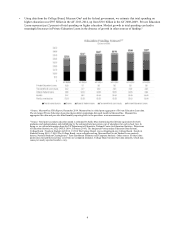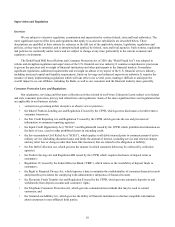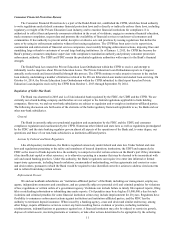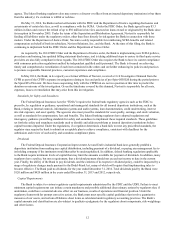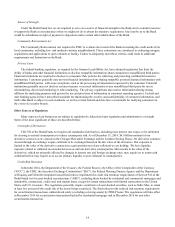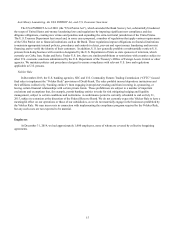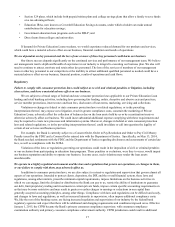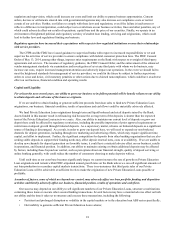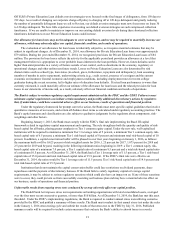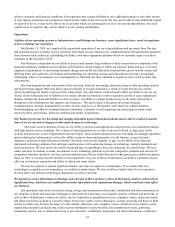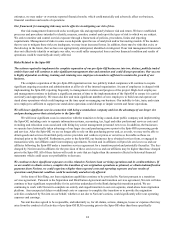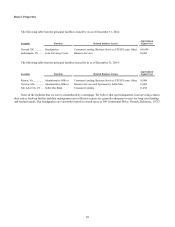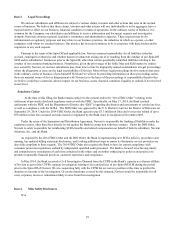Sallie Mae 2014 Annual Report Download - page 21
Download and view the complete annual report
Please find page 21 of the 2014 Sallie Mae annual report below. You can navigate through the pages in the report by either clicking on the pages listed below, or by using the keyword search tool below to find specific information within the annual report.• Degradation of the credit quality or performance of the Private Education Loans we sell to third-parties or to
securitization trusts, or adverse rating agency assumptions, ratings or conclusions with respect to those trusts;
• Material breach of our obligations to purchasers of our Private Education Loans, including securitization trusts;
• The timing and size of education loan asset-backed securitizations that other parties issue, or the adverse performance
of, or other problems with, such securitizations;
• Challenges to the enforceability of Private Education Loans based on violations of, or subsequent changes to, federal
or state consumer protection or licensing laws and related regulations, or imposition of penalties or liabilities on
assignees of Private Education Loans for violation of such laws and regulations; or
• Our inability to structure and gain market acceptance for new products or services to meet new demands of ABS
investors, rating agencies, or credit facility providers.
In structuring and facilitating securitizations of Private Education Loans, administering securitization trusts or providing
portfolio management, we may incur liabilities to transaction parties.
Under applicable state and federal securities laws, if investors incur losses as a result of purchasing ABS that our
securitization trusts issue, we could be deemed responsible and could be liable to investors for damages. We could also be liable
to investors or other parties for certain updated information that we may provide subsequent to the original ABS issuances by
the trusts. If we fail to cause the securitization trusts or other transaction parties to disclose adequately all material information
regarding an investment in any securities, if we or the trusts make statements that are misleading in any material respect in
information delivered to investors in any securities or if we breach any other duties as the administrator or servicer of the
securitization trusts, it is possible we could be sued and ultimately held liable by an investor or other transaction party. This risk
includes failure to properly administer or oversee servicing or collections and may increase if the performance of the
securitization trusts’ loan portfolios degrades. In addition, under various agreements, we may be contractually bound to
indemnify transaction parties if an investor is successful in seeking to recover any loss from those parties and the securitization
trusts are found to have made a materially misleading statement or to have omitted material information.
If we are liable to an investor or other transaction party for a loss incurred in any securitization we facilitate or structured
and any insurance that we may have does not cover this liability or proves to be insufficient, our business, financial position,
results of operations and cash flows could be materially adversely affected.
The interest rate characteristics of our earning assets do not always match the interest rate characteristics of our funding
arrangements, which may increase the price of, or decrease our ability to obtain, necessary liquidity.
Net interest income is the primary source of cash flow generated by our portfolios of Private Education Loans and FFELP
Loans. Interest earned on Private Education Loans and FFELP Loans is primarily indexed to one-month LIBOR rates, but our
cost of funds is primarily related to deposit rates. Certain of our Private Education Loans bear fixed interest rates. These loans
are not specifically match funded with fixed-rate deposits. Likewise, the average term of our deposits is shorter than the
expected term of our Private Education Loans.
The different interest rate and maturity characteristics of our loan portfolio and the liabilities funding that portfolio result
in interest rate risk, basis risk and re-pricing risk. In certain interest rate environments, this mismatch may compress our net
interest margin. It is not possible to hedge all of our exposure to such risks. While the assets, liabilities and related hedging
derivative contract repricing indices are typically highly correlated, there can be no assurance that the historically high
correlation will not be disrupted by capital market dislocations or other factors not within our control. In these circumstances,
our earnings could be materially adversely affected.
19


